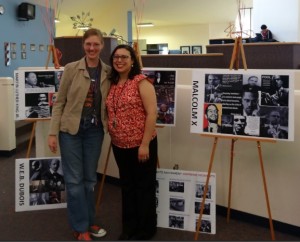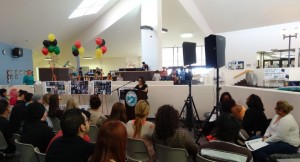The Read-In: An experiment in Black History Month engagement
15 September 2014 – Vanessa Macias
Every year, my college celebrates Black History Month and Hispanic Heritage Month. These celebrations feature musical performances, student art shows, guest speakers, and panel presentations that touch upon culture, community issues, significant men and women, landmark achievements, and current events. They are high-quality performances that attract large audiences of students, faculty, and members of the public. Yet from my perspective, the college’s scheduled events could focus more on the history of African Americans and Hispanics in the United States. It is imperative to include a discussion of historical themes and issues related to these groups to truly fulfill the mission of these special months. History can be celebratory, yet it can also be difficult, and these months should highlight both narratives. Minimizing discussion of history robs participants of a more profound experience that could challenge previously held assumptions.
The most “historical” event of our 2014 Black History Month celebration was Actor Phil Darius Wallace’s one-man performance as Malcolm X, in which Wallace interpreted Malcolm’s political development from boyhood to post-Nation of Islam. Based on the lively Q & A after the performance, audience members were clearly affected by Wallace’s powerful performance as well as intrigued by Malcolm’s life. What kind of activity could take advantage of this heightened interest in a significant historical figure?
Also in 2014, I hosted a lively participatory event called a Read-In. Since 1989, the Black Caucus of the National Council of Teachers of English (NCTE) has sponsored Read-Ins. Anybody can hold a Read-In; the only requirement is that selections must have been written by African Americans. In 2013, Read-Ins were held across the United States and Canada with more than 260,000 people participating. A Read-In encompassed all the elements I was looking for in a history-based activity:
- Simple concept: I kept the terms for participation as broad as the NCTE suggests. Participants had to read a selection from any African American author. No research or introduction to the author was necessary.
- Easy for students to get involved: Students could sign up to get a designated time to read, but I also kept it open for “walk-ins” if students decided to read on the day of the event. I offered extra credit to my students for participating, and my colleagues in different disciplines promoted the event in their classes as well.
- Low-risk: Read-Ins had been held on the largest campus of my college, but I had no idea how the event would be received at our smaller commuter campus. I was pretty confident I could recruit ten students from my classes to participate–additional students would be icing on the cake.

The author (right) and Speech Instructor Rebekah Bell (left), who helped recruit students to read at the event. Photo credit: Vanessa Macias
Much to my surprise, on the day of the event, I had thirty students signed up to read and a revolving audience of students and curious bystanders during the two-hour event. It went surprisingly well thanks to the help of my colleagues and the students who supported one another with rousing applause. Additional students even volunteered to read once they saw the other students. Luckily, I brought extra selections just in case.
The Read-In was a successful event in terms of student participation and audience. Our Campus Life department decorated the space with large illustrated biographies of significant African Americans and provided beverages that made the Read-In more of a campus event. Despite the success, something nagged at me: there wasn’t anything especially historical about the readings. I encouraged my students to select African American historical figures, yet most opted for poems and song/rap lyrics. Frederick Douglass, Sojourner Truth, and Barack Obama were read alongside Tupac Shakur and Maya Angelou. It was an interesting mix of images and ideas, but there was little sense of the historical context in which these figures wrote their words.
At its core, the Read-In is a simple concept: bring people together to speak profound words so others can hear them, let them sink in, and (maybe) feel inspired. The concept needs to be enhanced to reach my goal of bringing history to the forefront. For this fall’s Hispanic Heritage Month and next year’s Black History Month, I will make the following changes:
- Coordinate with the campus library: Since Black History and Hispanic Heritage Months occur a few weeks after the semester starts, I don’t have much class time to prepare students to participate in the Read-In. I plan to work with our campus library to develop an Online Library Research Guide to help students research biographies and make their selections for the event. Library displays for Black History and Hispanic Heritage Months will also include relevant sources.
- Connect the event to the month’s theme: 2014’s Hispanic Heritage Month theme is “Hispanics: A legacy of history, a present of action, and a future of success.” History, action, and success are starting points for students to select an author or significant individual to research. As students sign up, they will have to select which category that person falls under.
- Expand participation requirements: Students will need to research their author and write a short introduction for the selection they will read. The introduction should identify their author and put their selection into context.
These measures preserve the basic idea of the Read-In while adding the contextualization that was missing in the first Read-In. At the same time, I worry that adding too many requirements will discourage participation rather than make the event more meaningful. The Read-In needs to find the right balance as an accessible activity for community college students and an opportunity to work on research skills and public speaking while adding a historical perspective that is currently absent. Any suggestions?
~ Vanessa Macias teaches US History at El Paso Community College. She holds an MA in History (American West) from the University of New Mexico and an MA in Public History from New Mexico State University.




